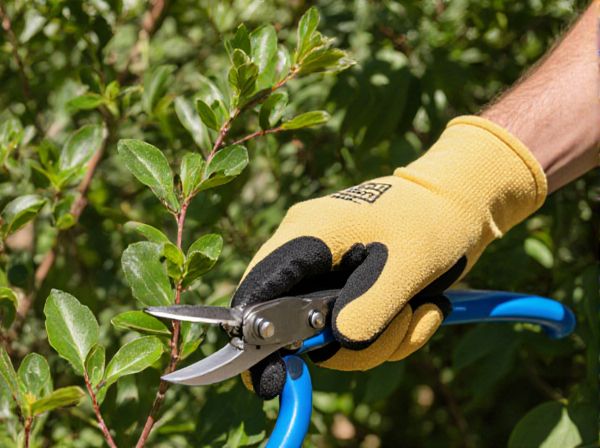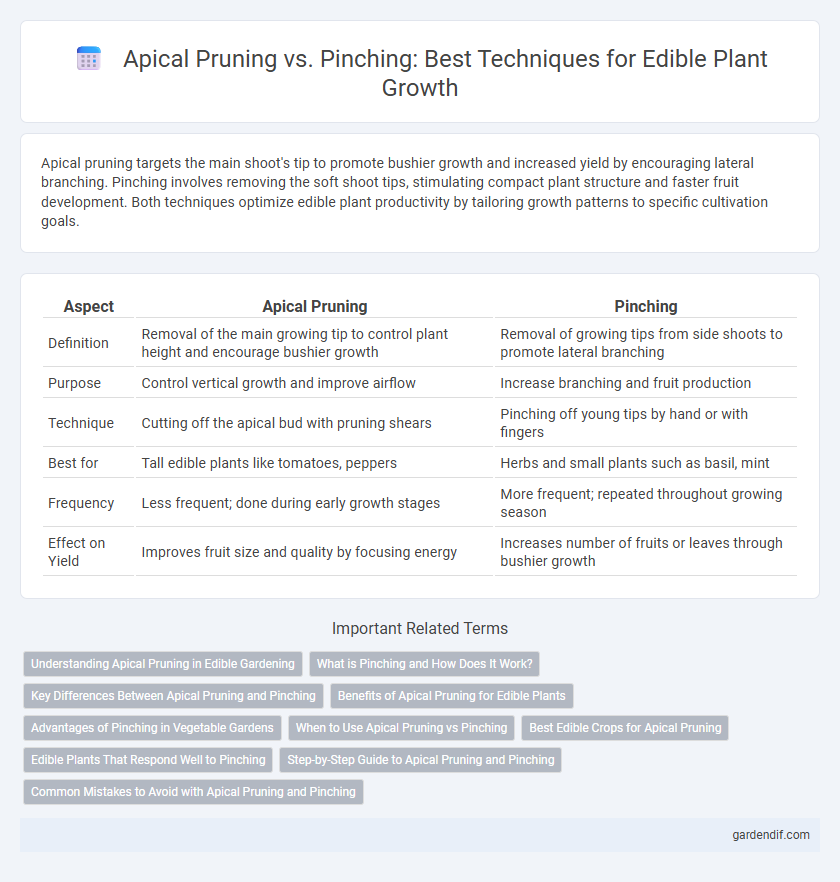
Apical Pruning vs Pinching Illustration
Apical pruning targets the main shoot's tip to promote bushier growth and increased yield by encouraging lateral branching. Pinching involves removing the soft shoot tips, stimulating compact plant structure and faster fruit development. Both techniques optimize edible plant productivity by tailoring growth patterns to specific cultivation goals.
Table of Comparison
| Aspect | Apical Pruning | Pinching |
|---|---|---|
| Definition | Removal of the main growing tip to control plant height and encourage bushier growth | Removal of growing tips from side shoots to promote lateral branching |
| Purpose | Control vertical growth and improve airflow | Increase branching and fruit production |
| Technique | Cutting off the apical bud with pruning shears | Pinching off young tips by hand or with fingers |
| Best for | Tall edible plants like tomatoes, peppers | Herbs and small plants such as basil, mint |
| Frequency | Less frequent; done during early growth stages | More frequent; repeated throughout growing season |
| Effect on Yield | Improves fruit size and quality by focusing energy | Increases number of fruits or leaves through bushier growth |
Understanding Apical Pruning in Edible Gardening
Apical pruning in edible gardening involves selectively cutting the main growing tip of a plant to encourage bushier growth and increased fruit production. This technique redirects the plant's energy from vertical growth to lateral branch development, enhancing overall yield and ease of harvest. Properly executed apical pruning improves airflow and light penetration, reducing disease risk and promoting healthier, more productive edible plants.
What is Pinching and How Does It Work?
Pinching is a horticultural technique involving the removal of the growing tip of a plant, typically by using fingers to snip off tender shoots. This method stimulates lateral growth by redirecting the plant's energy from vertical extension to the development of side branches, resulting in a bushier and more productive structure. Commonly utilized in edible gardening for herbs and vegetables like tomatoes and basil, pinching enhances yield and improves airflow around the plant, reducing disease risks.
Key Differences Between Apical Pruning and Pinching
Apical pruning involves selectively cutting the top growth of a plant to promote lateral branching and overall size control, whereas pinching removes the soft tips of new growth to encourage bushier development. Apical pruning is more aggressive, often reducing height significantly, while pinching is gentler, mainly enhancing density without drastic size reduction. Both techniques optimize plant structure and productivity but differ in intensity and specific growth outcomes.
Benefits of Apical Pruning for Edible Plants
Apical pruning enhances edible plant health by stimulating lateral growth, resulting in bushier plants with increased fruit or vegetable yield. This technique improves light penetration and air circulation around the canopy, reducing the risk of fungal diseases and promoting robust development. By directing energy towards productive branches, apical pruning maximizes the quality and quantity of harvestable crops in edible gardening.
Advantages of Pinching in Vegetable Gardens
Pinching offers precise control over plant growth, promoting bushier and more productive vegetable plants. This technique enhances air circulation and light penetration, reducing the risk of fungal diseases and improving overall plant health. Pinching also encourages the development of multiple fruit-bearing branches, leading to higher yields in vegetable gardens.
When to Use Apical Pruning vs Pinching
Apical pruning is best used during the early vegetative stage to encourage strong vertical growth and a dominant main stem, optimizing light exposure and energy distribution. Pinching is ideal for promoting bushier plants by removing the shoot tips after the plant has developed several sets of leaves, enhancing lateral branching and increasing yield. Choosing between apical pruning and pinching depends on the desired plant structure, growth phase, and cultivation goals.
Best Edible Crops for Apical Pruning
Apical pruning enhances the growth of fruit-bearing plants like tomatoes, peppers, and eggplants by promoting lateral branching and increasing yield. Best edible crops for apical pruning include tomatoes, cucumbers, and strawberries, which benefit from controlled top growth to improve sunlight exposure and air circulation. This technique encourages stronger stems and higher-quality fruit production in these versatile edible plants.
Edible Plants That Respond Well to Pinching
Edible plants such as tomatoes, basil, and peppers respond well to pinching by encouraging bushier growth and increased yield. Pinching the tips of these plants removes apical dominance, prompting lateral branching that enhances fruit production and overall plant health. This technique is especially effective in herbs and fruiting vegetables, optimizing both space and nutrient use.
Step-by-Step Guide to Apical Pruning and Pinching
Apical pruning involves cutting the main growing tip of a plant to encourage lateral growth and bushier development by removing the terminal bud, usually done when the plant reaches 6-12 inches in height. Pinching, by contrast, entails using fingers or scissors to remove the small shoot tips or young leaves to promote branching and control size, typically performed regularly throughout the growing season. Both methods improve airflow and light penetration but require careful timing: apex pruning is done once or twice early in growth, while pinching is repeated to maintain plant shape.
Common Mistakes to Avoid with Apical Pruning and Pinching
Common mistakes to avoid with apical pruning include cutting too much of the main stem, which can stunt plant growth and reduce yield. Pinching errors often involve removing too many new shoots, leading to insufficient foliage for photosynthesis and weaker plant structure. Both techniques require careful timing and moderation to promote healthy branching and maximize edible harvests.
Apical Pruning vs Pinching Infographic

 gardendif.com
gardendif.com